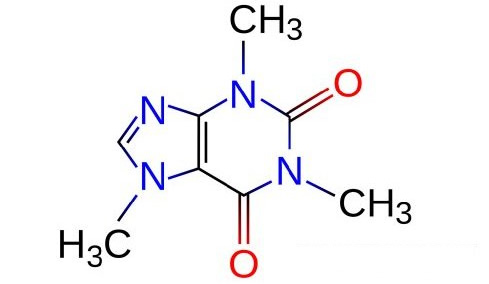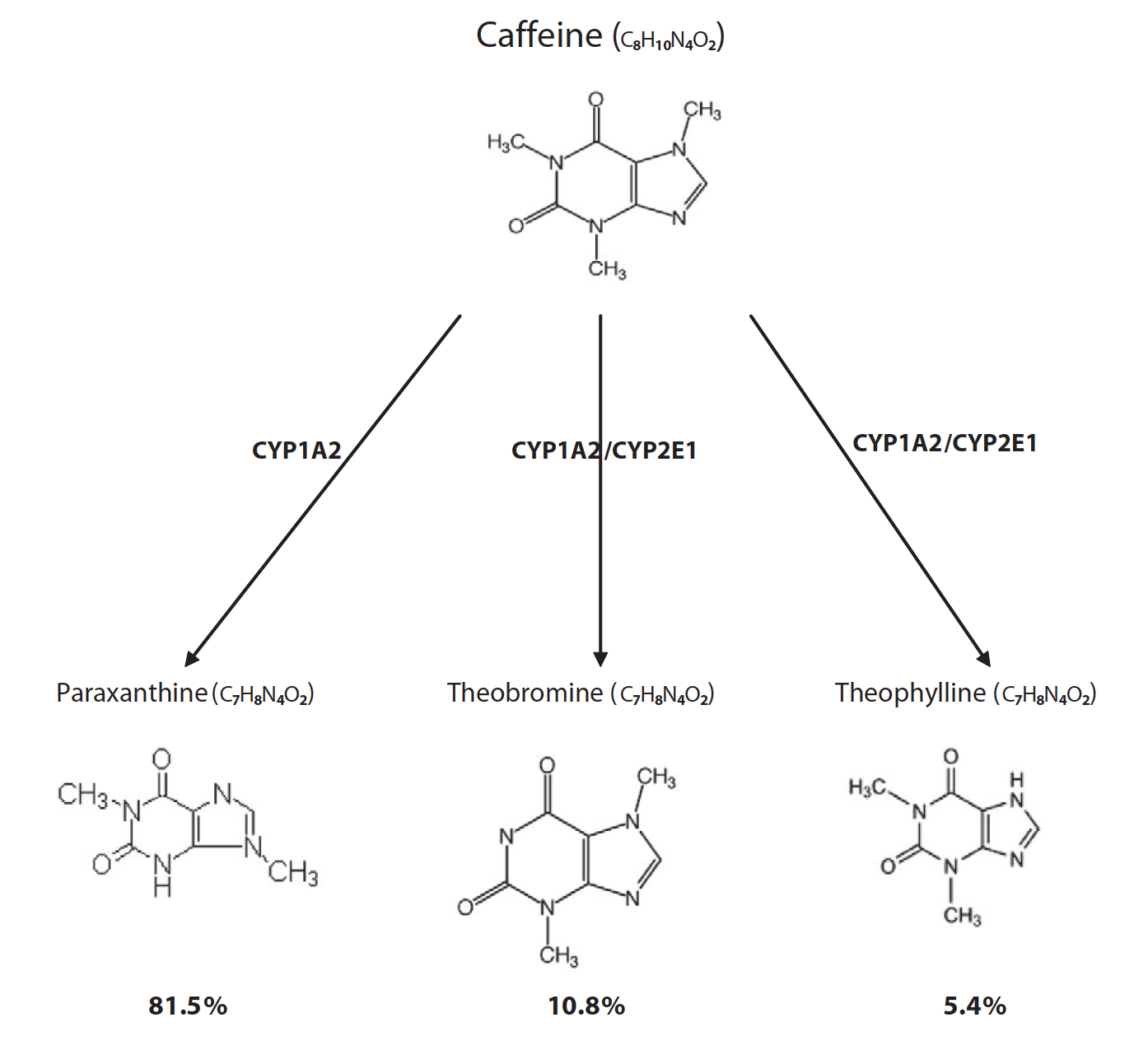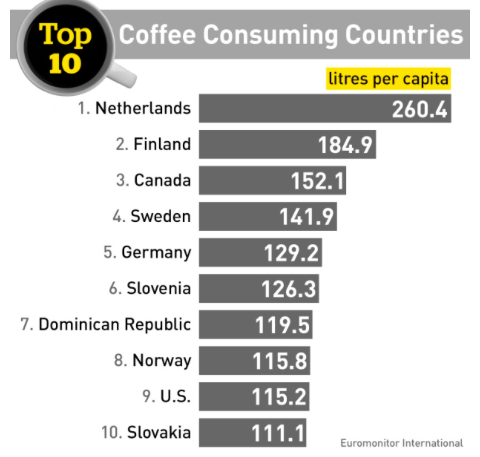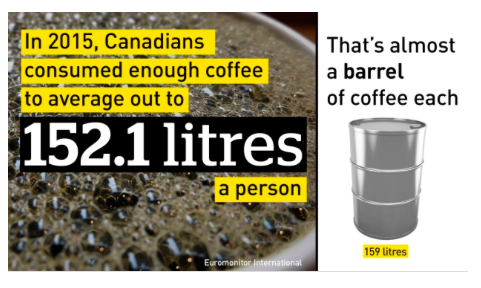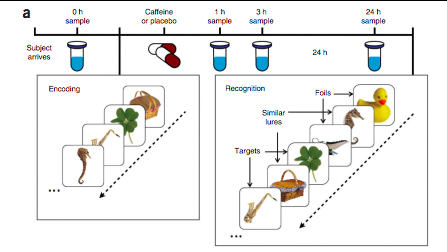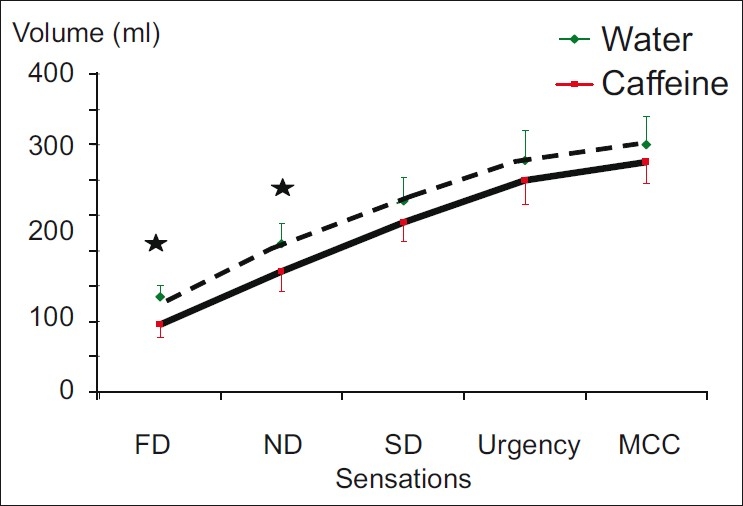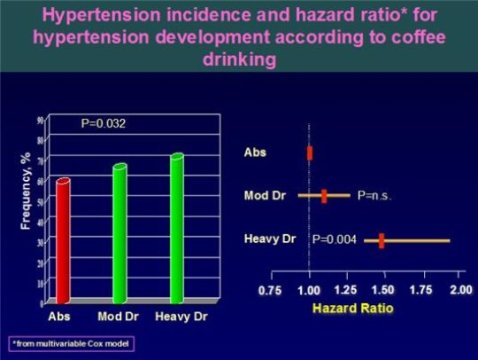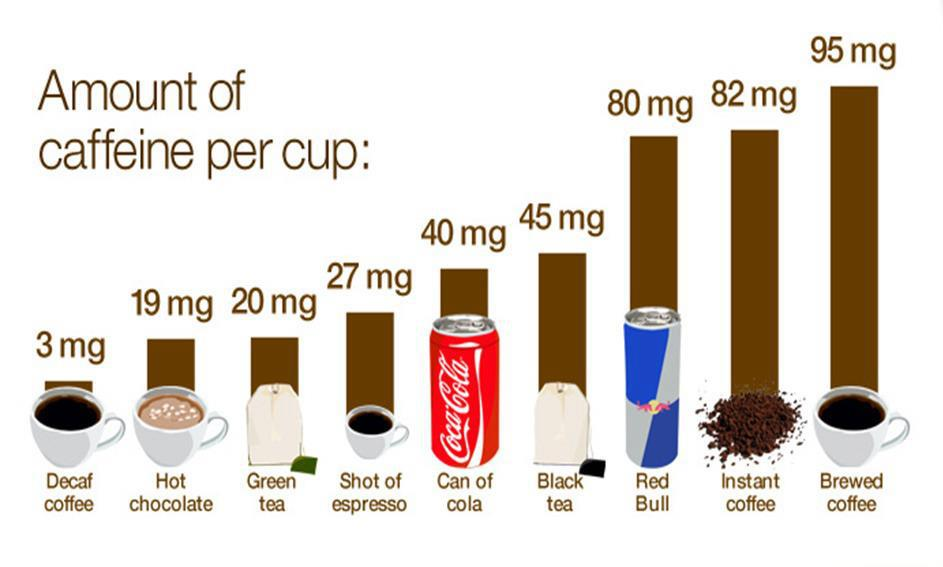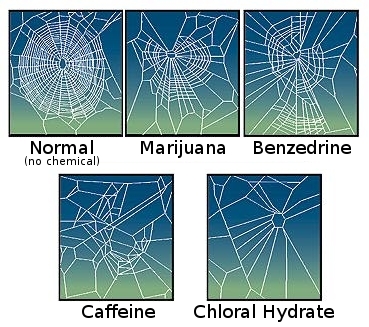This is an old revision of the document!
Table of Contents
group_2-presentation_2-effects_of_caffeine.pptx
What is Caffeine?
Caffeine is a type drug from the methylxanthines class, meaning that it has a purine base. Purine base consist of a six-membered and a five-membered nitrogen-containing ring, bound together. Caffeine is a legal psychoactive drug and is popularly consumed in coffee, tea and cola drinks. (Nehlig, Daval & Debry, 1992)
Mechanisms of Caffeine
99% of caffeine is absorbed in humans within 45 minutes of ingestion (Institute of Medicine (US) Committee on Military Nutrition Research, 2001). Caffeine is absorbed through the gastrointestinal tract, and due to the fact that it has lipophilic properties, it passes through the phospholipid bilayer of cells such as absorptive cells of the intestines (Fredholm, Bättig, Holmén, Nehlig & Zvartau, 1999). Almost all of the ingested caffeine is metabolized by the CYP1A2 enzyme. Caffeine is metabolized to paraxanthine (81.5%) and to theobromine (10.8%) and theophylline (5.4%) (Perera, Gross & McLachlan, 2010). Caffeine can also travel to the brain and pass the blood-brain barrier (Fredholm, Bättig, Holmén, Nehlig & Zvartau, 1999) and can act as a central nervous system (CNS) stimulant (Nehlig, Daval & Debry, 1992). Paraxanthine, which is the main metabolite of caffeine, can pass through the placental barrier, and reach the fetus (Jahanfar & Jaafar, 2013).
A likely mechanism of caffeine involves the binding of caffeine to adenosine receptors and inducing an antagonistic effect (Mendel, 2002). It is important to note that adenosine receptors are found all over the body, including the brain, heart, lung, kidney and the gastrointestinal tract. Adenosine induces a drowsiness or sleepiness effect after prolonged period of awakeness. Although the mechanism of this effect is not determined yet, one postulated mechanism is that adenosine inhibition of cholinergic neurons in the basal forebrain, which normally produce arousal (Roehrs & Roth, 2008). The underlying biochemical changes that induce these effects include depression of spontaneous electrical activity of the neurons, inhibition of synaptic transmission and release of neurotransmitters (Nehlig, Daval & Debry, 1992). Research has shown that upon injection of adenosine, various animal species experience slow-wave sleep and reduced vigilance. Caffeine has an antagonistic effect, meaning that it competes with adenosine to bind to adenosine receptors, but it doesn't activate the receptor.
Adenosine receptors are a type of G-protein coupled receptors, which are involved in a signal transduction pathway and their job is to ultimately induce a cell response (Fisone, Borgkvist & Usiello, 2004). There are four subclasses of the adenosine receptors, two of which include: A1 and A2 receptors. One of the differences between these two receptors arises from the affinity they have for adenosine as A1 has a high affinity, whereas A2 has a relatively low affinity (Nehlig, Daval & Debry, 1992). Once adenosine is bound to A1 or A2, it inhibits or stimulates adenylate cyclase respectively and eventually has an effect on the concentration of cyclic AMP (Benowitz, 1990).
Since the structures of caffeine and adenosine are similar, caffeine can also bind to adenosine receptor, and inhibit the binding of adenosine to the A1 and A2 receptors. Normally, adenosine binds to adenosine receptors and when there is sufficient amount of binding, it causes the “sleepiness” effect. This effect is due to adenosine’s ability to presynaptically inhibit the release of acetylcholine, norepinephrine, dopamine, gamma amino butyric acid, and serotonin. Furthermore, it is able to reduce the rate of spontaneous firing of different areas of the brain produces sedation, and has anticonvulsant activity. Since adenosine is being inhibited in the presence of caffeine, all it’s effects are being reversed. Caffeine is able to block the A2 receptor in the basal ganglia such as the corpus striatum and globus pallidus, through which it can induce stimulatory effects. These stimulatory effects induced by caffeine includes the release norepinephrine, dopamine, and serotonin in the brain. (Cappelletti, Daria, Sani, & Aromatario, 2015)
Frequent Users
In Canada, on average, individual’s drink approximately 152.1 litres of coffee per person annually. However, this does not include other beverages that has caffeine in it, such as tea, soda, and energy drinks. This makes Canada the third country in the world to drink the most coffee. (Harris, 2016)
Other data to support this is that Canadians consume 180 mg of caffeine in coffee per day, significantly higher than all but two other countries. When considering caffeinated drinks altogether, 73.6% of Canadians aged 12-24 consume a beverage that has caffeine (including coffee, tea, soda, and energy drinks) and 16% of caffeine consumers report exceeding two or more caffeinated drinks per day.
Studies have shown that the coffee demand is growing and breaking historical records thanks to millennials of ages 19-34. In the United States, millennials consume 44% of the coffee consumed. Those born after 1995 started drinking coffee at about 14.7 years of age, in contrast to those born in the 1980’s that started drinking coffee at 17.1 years of age. This could be due to the increase in trend to drink coffee, as it has become a cultural and social activity. (Heath, 2016)
General Side Effects
The concentration of caffeine in the blood peaks 30-60 minutes after it is consumed, and has a half life from two to ten hours. This means that in approximately twelve hours most of the caffeine is diminished from the body. During that time the caffeine has peaked in the body, medical studies have linked caffeine use to a spectrum of symptoms. Some of which include:
- Aggravation
- Improving performance of simple tasks, athletic performance
- Impairing short term memory
- Increasing concentration, insomnia, restlessness, alertness, attentiveness
- Suppressing appetite
Specifically, 1 gram of caffeine (equivalent to about six cups of coffee), can induce:
- Insomnia
- Restlessness
- Ringing in the ears
- Confusion
- Tremors
- Cardiac arrhythmias
- Vomiting
- Diarrhea
(Weinberg, & Bealer, 2001)
Positive Effects of Caffeine Consumption
In 2010, Dr. Glade conducted a literature review (Glade, 2010) to discover the various beneficial effects of caffeine consumption. He identified specific benefits when consuming a moderate amount of caffeine such as its ability to:
- Increase energy availability
- Increase daily energy expenditure
- Decrease fatigue
- Decrease the sense of effort associated with physical activity
- Enhance physical performance
- Enhance motor performance
- Enhance cognitive performance
- Increase alertness, wakefulness, and feelings of “energy”
- Decrease mental fatigue
- Quicken reactions
- Increase the accuracy of reactions
- Increase the ability to concentrate and focus attention
- Enhance short-term memory
- Increase the ability to solve problems requiring reasoning
- Increase the ability to make correct decisions
- Enhance cognitive functioning capabilities and neuromuscular coordination
This literature reviews shows that caffeine is not just considered a stimulant but rather it also produces specific effects that consumers may not think of.
Caffeine Consumption and Short-Term Memory Enhancement
Caffeine Consumption Post-study
One particular caffeine benefit that is quite beneficial to students is the enhancement of short-term memory. When examining short-term memory consolidation, researchers have analyzed the effects of consuming caffeine post-study, and the effects of consuming caffeine before studying. Borota et al. tested the effect of drinking caffeine after studying images with 160 participants (ages 18-30) who were not habitual caffeine drinkers. The participants were randomized into either a caffeine-intake group or a placebo group. Each participant studied images in a process called “encoding” which is the start of learning new information and is the first step of forming memories. After the participants finished viewing the images, they were given either a 200mg caffeine pill or a placebo. After 24 hours, the participants completed a judgement task in which they were asked if the image they is old (an image they saw), new, or similar to the images they studied the day before. Those who received caffeine were able to recognize which images were similar to the studied images, as opposed to confusing them for images they have previously seen. To test which dosage would be produce the best effects, the researchers repeated the study with 100 mg and 300 mg. It was found that 300 mg produced the best results, but was not anymore beneficial than 200 mg, so at least 200 mg is recommended for these effects (Borota et al., 2014). The exact mechanisms of improved memory consolidation due to caffeine is not yet known but it is proposed that when caffeine blocks adenosine, it prevents the inhibition of norepinephrine in the amygdala which positively consolidates memory (McGaugh, 2000).
Caffeine Consumption Pre-study
In a second study, the effects of drinking caffeine before studying was explored. This study examined the effects of caffeine consumption on event-based and time-based prospective memory in 43 regular caffeine drinkers. Half of the participants were given 50 mg via an instant coffee drink, and the other half received decaffeinated coffee (which contains about 1.8 mg of caffeine) prior to the start of their task. Participants were entered into a virtual setting in which they had to complete tasks in order to get ready for a work meeting. This specific setting is to test two different types of memory; event-based and time-based prospective. Event-based prospective memory is the ability to remember to carry out a task when prompted by an event which appeared as you were carrying out another task. Time-based prospective memory is remembering to carry out a task at a specific time. It was found that those who consumed the caffeinated drink were more accurate in both their event-based and time-based prospective memory (87%, 80%) compared to those who consumed a decaffeinated drink (72%, 69%) (Soar, Chapman, Lavan, Jansari, & Turner, 2016).
Negative Effects of Caffeine Consumption
After having read about the effects of caffeine on the body, it has been noted that caffeine, (the only socially acceptable psychoactive drug), has negative effects on the body if consumed in higher doses (Whiteman, 2015). According to the Mayo Clinic, consuming about 500-600 mg of caffeine a day may lead to:
- Insomnia
- Nervousness
- Restlessness
- Irritability
- A faster heartbeat
- Muscle tremors
(Mayo Clinic, 2017)
The three negative effects that will be talked about are:
- Frequency of urination
- Causing changes in mood
- Increased risk of cardiovascular events
(European Society of Cardiology, 2015)
Figure 6: This image shows sensation and volumes at bladder filling phases (mean±SE) in milliliters after water and caffeine ingestions (n=12) (FD=first desire to void, ND=normal desire to void, SD=strong desire to void, MCC=maximal cystometric capacity); * P≤0.05 on comparing the volumes after water and caffeine ingestions (Lohsiriwat, 2011).
Lohsiriwat, 2011 (Urgency and Frequency of Urination)
A study looked at effects of caffeine on bladder function in patients with overactive bladder symptoms. Specifically, they looked at the effect of caffeine at a dose of 4.5 mg/kg on bladder function in overactive bladder adults. After ingestion of caffeine, at the dose mentioned, there was a decreased threshold of sensation at filling phase, meaning that you feel full earlier and the desire to urinate comes earlier, as well as an increase in flow rate of urine and voided volume. Therefore, caffeine can promote early urgency and frequency of urination as proved in the study as well as nocturia symptoms (Lohsiriwat, 2011). Nocturia is defined as a person having the complaint that they need to wake up frequently in the middle of the night for things such as urination (MedicineNet, 2016). Frequent urination would cause dehydration really quickly and this would lead to increased water loss.
Mayo Clinic, 2017
It is found that caffeine dulls the nerves that transmit messages between the bladder and the brain. With excess caffeine or a higher dosage, those nerves then are not able to recognize that the bladder has become full and results in an overflowing bladder and involuntary urine leakage. Therefore, it is important for people to stay hydrated with water or anything that gives the body the electrolytes needed, not just caffeine. Taking this at a more relatable level, people who consume caffeine on a higher dose are, evidently, students, the working class, people who are busy and need that quick dose of alertness to start their day or stay up the night to study for an exam. In this hustle, they tend to rely on caffeine, mostly likely coffee as seen in today’s culture, to get them through their day. Higher amounts of caffeine, frequent and urgent of urination, causing increased water loss and electrolytes. It is fortunate however, that caffeine does not cause a dehydrating effect even if it is a diuretic. (Mayo Clinic, 2017)
Moawad, 2011 (Mood Changes)
People who consume caffeine, causes them to become irritable and anxious and in turn may affect their productivity. The reason why this happens is due to the enhanced alertness that caffeine induces. The enhanced alertness translates to enhanced focus on stimuli that does not need attention and may cause them to become irritated based on their tasks they need to get done and in turn, anxious towards not being able to get their tasks done. This is varied in persons, people who are not regular in-takers of caffeine may feel enhanced of these effects of irritableness and anxiety. (Moawad, 2017)
In another study, it was found that caffeine reduced fatigue (Loke, 1988), however it also led to increased tension and nervousness (Smith, 2002). Also, Lieberman, 1992, stated that, caffeine seems to increase anxiety when administered in single doses of 300 mg or higher. Of course this is a lot more than a typical caffeine-containing beverage, again increased intake of caffeine, increased effects of mood changes.
Dr. Mos, 2015 (Risk of Cardiovascular Events)
Coffee Drinking and Hypertension
In a 12 year study, done by a cardiologist in Italy, Dr. Lucio Mos, evaluated the effects of coffee drinking in more than 1, 200 patients. He wanted to see if coffee drinking had an effect on the risk of cardiovascular events and if the link was mediated by effects on blood pressure and glucose metabolism. The summary of the results were that heavy coffee drinkers, meaning they have 4 cups or more of coffee, had a four-fold increased risk of mild hypertension, and moderate coffee drinkers, having 1-3 cups of coffee a day, tripled their risk. (European Society of Cardiology, 2015)
How the Research was Conducted
The participants that were included in the study were from ages 18-45, non-diabetic patients from a prospective study who were untreated of stage 1 hypertension, meaning they had systolic pressure of 140-159 mmHg and diastolic pressure of 90 and 99 mmHg. The way the patients were categorized was based on coffee consumption, by the number of caffeine-containing cups per day: so there were non-drinkers, which had no caffeine-containing cups, moderate drinkers who had 1-3 cups of caffeine-containing cups per day, and heavy drinkers who had 4 or more cups of caffeine-containing cups per day. So out of the participants then, 26.3% of them were abstainers, never had coffee, thus no caffeine-containing cups, 62.7% were moderate coffee drinkers and 10% were heavy coffee drinkers. The coffee drinkers, they noted, were older of the 18-45 age group and had a higher body mass index than the ones who did not drink coffee. From this study, Dr. Mos found that there was a linear relationship between the consumption of coffee, caffeine-containing, and risk of hypertension, needing treatment. This relationship actually had statistical significance for the heavy drinkers of coffee of this study. The study also found a linear relationship between long term coffee drinking and risk of developing prediabetes, with a 100% increased risk of prediabetes in the participants who were heavy coffee drinkers. This however, was true for individuals with slow caffeine metabolizers, and this was according to the CYP1A2 genotype, that decides if the individuals can metabolize caffeine faster or slower. (European Society of Cardiology)
Dr. Mos concluded from the study that drinking coffee, a caffeine-containing drink, increases the risk of prediabetes in young adults who are slow caffeine metabolizers.
He also said, “Slow caffeine metabolizers have longer exposure to the detrimental effects of caffeine on glucose metabolism and that the risk is even greater if they are overweight or obese and if they are heavy coffee drinkers. Thus the effect of coffee on prediabetes depends on the amount of daily coffee intake and genetic background.“
Furthermore, in this 12 and a half year study, there were 60 cardiovascular events that occured. About 80% of these events were heart attacks and the remaining events were things such as strokes, peripheral artery disease and kidney failure.
Therefore, the conclusions that were made by Dr. Mos, “Our study shows that coffee use is linearly associated with increased risk of cardiovascular events in young adults with mild hypertension. This relationship seems to be at least partially mediated by the long term effect on blood pressure and glucose metabolism. These patients should be aware that coffee consumption may increase their risk of developing more severe hypertension and diabetes in later life and should keep consumption to a minimum.” (European Society of Cardiology, 2015)
Amount of Caffeine Present in Typical Drinks
Caffeinated Spider
History of Famous Coffee Chains
Coffee is considered to be an essential element in our daily lives because coffee has the highest Caffeine concentration of 95 mg per cup as mentioned in the previous information. Coffee is indeed has become a tradition in almost every society in every country on this planet due to its heavy consumption by people. There are twelve famous coffee chains; these chains are distributed in nearly every country. These chains are Gloria Jean's Coffee, Caribou Coffee, Coffee Beanery, Dunkin's’ Donuts, Starbucks coffee, McCafe, Costa Coffee, Tully’s Coffee, Peet's Tea and Coffee, Lavazza Coffee, Bewley’s Coffee and Tim Hortons (Top 12 Largest Coffee, 2010). In Canada in Particular, the three most famous chains are:
Tim Hortons
It's Known to be Canada’s favorite coffee. It’s a Canadian chain, and it was founded in 1964 by Miles Gilbert “Tim Hortons” which he was a famous hockey player in Canada. It’s the largest quick service restaurant in Canada. There are 4000 stores all around the globe with revenue of 3.225 Billion US Dollar annually with over 100’000 employees (Top 12 Largest Coffee, 2010). There are 3802 stores in Canada alone and its expanding every year.
Starbucks
It was founded in 1971 by Three people named: Jerry Baldwin, Zev Siegel, and Gordon Bowker in the United States of America. There are approximately 21,000 shops all over the world with a revenue of over 16 billion US Dollar (Top 12 Largest Coffee, 2010). In Canada alone, there approximately 1200 shops and this number is rising every year. The first shop was opened for the first time in Vancouver in 1987 at Seabus Skytrain Station (Our Canadian story, 2018)
McCafe
This Coffee chain is partially part of the McDonald’s chain which is one of the largest fast-food chains in the world. Their coffee chain was founded in 1993 by Dick and Mac McDonald in the United States of America. However, the coffee chain was officially in stores in 2002; there are around 300 stores worldwide with estimated revenue of 1.86 Billion US Dollar mostly is found in USA and Canada (Top 12 Largest Coffee, 2010). The first store in Canada was launched in 2011 (Our History, 2018)
Facts
- The first Tim Hortons store was founded in Hamilton, its close to Downtown Hamilton actually in 1964
- There is a Tim Hortons store for every 9000 Canadians in Canada. Which makes Tim Hortons, the most popular coffee in Canada.
- 80% of the world's population consume caffeinated products as their wake-up boost
- In 2015 Canada has ranked No.1 in Coffee consumption per person. As an average of 152.1 L per person.
- Coffee can kill you but it’s very unlikely if you consume more than 4000 mg/day then it's fatal which is about 26 cups/ day.
Conclusion
Caffeine is not just a stimulant - it can produce numerous positive and negative effects, and it widely consumed across the world. There have been studies that show their positive effects, with enhanced short-term memory as a benefit to students. However, it has been shown that consuming numerous cups of coffee per day can worsen existing conditions such as overactive bladders and hypertension. Based on all studies included, it is recommended to consume 200 mg of caffeine in order to experience positive benefits.
References
- Bellet, S., Roman, L., DeCastro, O., Kim, K. E., & Kershbaum, A. (1969). Effect of coffee ingestion on catecholamine release. Metabolism-Clinical and Experimental, 18(4), 288-291.
- Benowitz, N. L. (1990). Clinical pharmacology of caffeine. Annual review of medicine, 41(1), 277-288.
- Borota et al. (2014). Post-study caffeine administration enhances memory consolidation in humans. Nature Neuroscience, 17, 201-203.
- Castle, E.P. (2017). Urinary Incontinence. Mayo Clinic. Retrieved from www.mayoclinic.org/diseases-conditions/urinary-incontinence/symptoms-causes/syc-20352808
- Claypool, S. (2016). What are the benefits of drinking coffee? Quora. Retrieved from https://www.quora.com/What-are-the-benefits-of-drinking-coffee
- Cappelletti, S., Daria, P., Sani, G., & Aromatario, M. (2015). Caffeine: cognitive and physical performance enhancer or psychoactive drug? Current neuropharmacology, 13(1), 71-88.
- MedicineNet. (2016). Medical Definition of Nocturia. MedicineNet. Retrieved from www.medicinenet.com/script/main/art.asp?articlekey=4571.
- European Society of Cardiology. (2015). Coffee linked with increased cardiovascular risk in young adults with mild hypertension. ScienceDaily. Retrieved from www.sciencedaily.com/releases/2015/08/150829123701.htm
- Glade, M.J. (2010). Caffeine-Not just a stimulant. Nutrition, 26(10), 932-938.
- Greden et al. Anxiety and Depression Associated with Caffeinism Among Psychiatric Inpatients. American Journal of Psychiatry, 133:8, Aug 1978.
- Greden, J. F., Fontaine, P., Lubetsky, M., & Chamberlin, K. (1978). Anxiety and depression associated with caffeinism among psychiatric inpatients. The American journal of psychiatry, 135(8):963-6.
- Greden, J. F. (1974). Anxiety or caffeinism: a diagnostic dilemma. American Journal of Psychiatry, 131(10), 1089-1092.
- Harris, S. (2016). Why Canadians drink more coffee than most people in the world. CBC. Retrieved from: http://www.cbc.ca/news/business/canada-coffee-tim-hortons-1.3745971
- Heath, T. (2016). Look how much coffee millennials are drinking. Washington Post. Retrieved from: https://www.washingtonpost.com/news/business/wp/2016/10/31/look-how-much-coffee-millennials-are-drinking/?utm_term=.35099b8ce2cf
- Hensrud, D., Nelson, J.K., & Zeratsky K. (2017). Caffeine: How Much Is Too Much? Mayo Clinic. Retrieved from: www.mayoclinic.org/healthy-lifestyle/nutrition-and-healthy-eating/in-depth/caffeine/art-20045678?reDate=14022018
- Fisone, G., Borgkvist, A., & Usiello, A. (2004). Caffeine as a psychomotor stimulant: mechanism of action. Cellular and Molecular Life Sciences CMLS, 61(7-8), 857-872.
- Fredholm, B. B., Bättig, K., Holmén, J., Nehlig, A., & Zvartau, E. E. (1999). Actions of caffeine in the brain with special reference to factors that contribute to its widespread use. Pharmacological reviews, 51(1), 83-133.
- Larne, S.G. (2015). Norepinephrine. PsychiatricDrugs. Retrieved from http://psychiatricdrugs.com/neurology/norepinephrine/
- Lohsiriwat, S., Hirunsai, M., & Chaiyaprasithi, B. (2011). Effect of caffeine on bladder function in patients with overactive bladder symptoms. Urology annals, 3(1), 14.
- Mandel, H. G. (2002). Update on caffeine consumption, disposition and action. Food and Chemical Toxicology, 40(9), 1231-1234.
- McGaugh, J.L. (2000). Memory–a Century of Consolidation. Science, 287(5451), 248-251.
- Moawad, H. (2017). Why Coffee Causes Irritability and Anxiety. Livestrong. Retrieved from: www.livestrong.com/article/368997-why-coffee-causes-irritability-anxiety/
- Nehlig, A., Daval, J. L., & Debry, G. (1992). Caffeine and the central nervous system: mechanisms of action, biochemical, metabolic and psychostimulant effects. Brain Research Reviews, 17(2), 139-170.
- Sherman, S.M., Buckley, T.P., Baena, E., & Ryan, L. (2016). Caffeine Enhances Memory Performance in Young Adults during Their Non-optimal Time of Day. Frontiers in Psychology, 7:1764.
- Smith, A. (2002). Effects of caffeine on human behavior. Food and chemical toxicology, 40(9), 1243-1255.
- Weinberg, B. A., & Bealer, B. K. (2001). The world of caffeine: the science and culture of the world's most popular drug. Psychology Press. Retrieved from https://books.google.ca/books/about/The_World_of_Caffeine.html?id=YdpL2YCGLVYC
- Institute of Medicine (US) Committee on Military Nutrition Research. Caffeine for the Sustainment of Mental Task Performance: Formulations for Military Operations. Washington (DC): National Academies Press (US); 2001. 2, Pharmacology of Caffeine. Retrieved from: https://www.ncbi.nlm.nih.gov/books/NBK223808/
- Roehrs, T., & Roth, T. (2008). Caffeine: sleep and daytime sleepiness. Sleep medicine reviews, 12(2), 153-162.
- Soar, K., Chapman, E., Lavan, N., Jansari, A.S., & Turner, J.J.D. (2016). Investigating the effects of caffeine on executive functions using traditional Stroop and a new ecologically-valid virtual reality task, the Jansari assessment of Executive Functions (JEF©). Appetite, 105, 156-163.
- Jahanfar, S., & Jaafar, S. H. (2013). Effects of restricted caffeine intake by mother on fetal, neonatal and pregnancy outcome. Cochrane Database Syst Rev, 2.
- Perera, V., Gross, A. S., & McLachlan, A. J. (2010). Caffeine and paraxanthine HPLC assay for CYP1A2 phenotype assessment using saliva and plasma. Biomedical Chromatography, 24(10), 1136-1144.
- Winstead, D. K. (1976). Coffee consumption among psychiatric inpatients. The American Journal of Psychiatry, 133(12), 1447-1450.
- Zeratsky K. (2017). The Myth about Caffeine and Dehydration. Mayo Clinic. Retrieved from www.mayoclinic.org/healthy-lifestyle/nutrition-and-healthy-eating/expert-answers/caffeinated-drinks/faq-20057965
